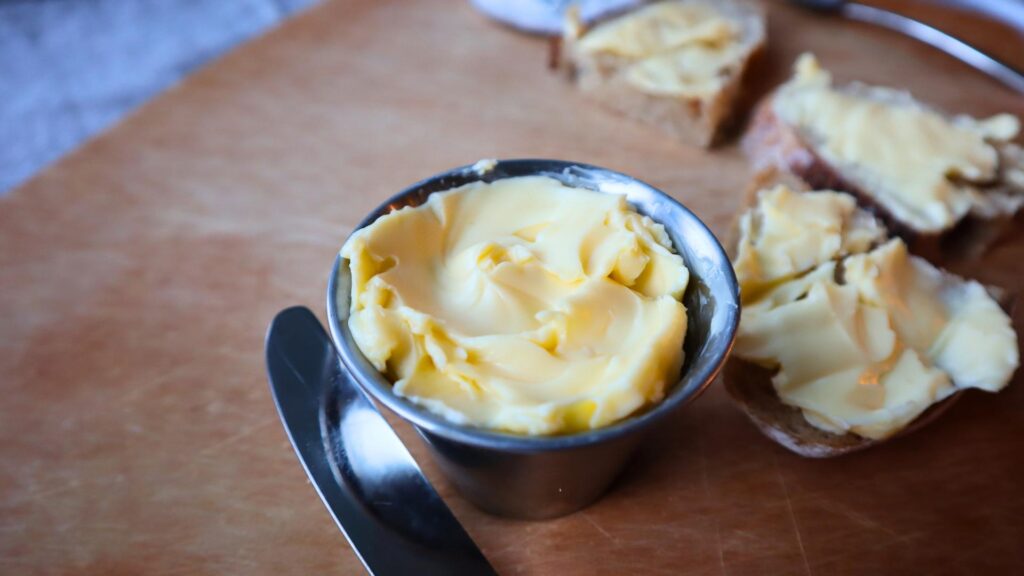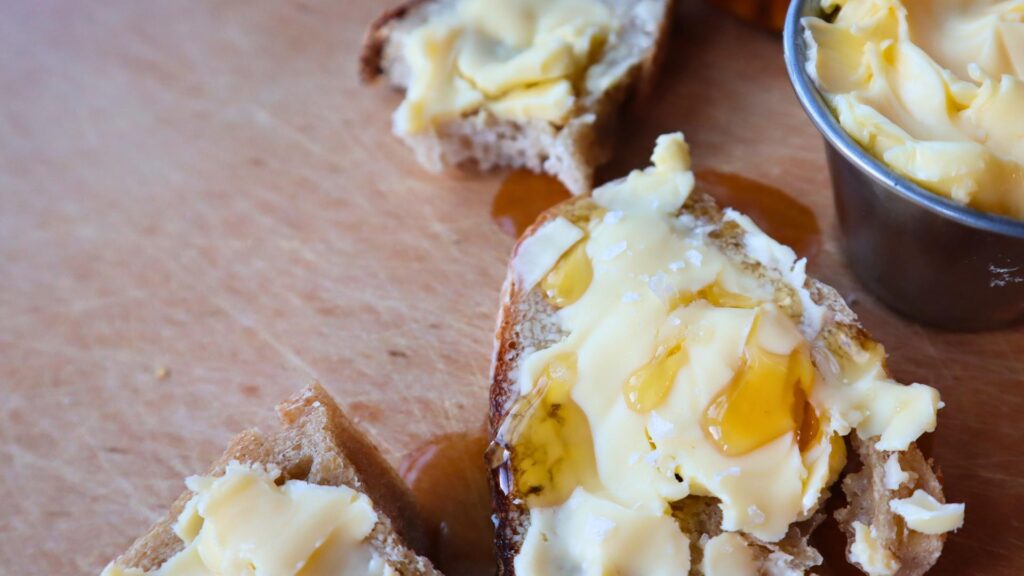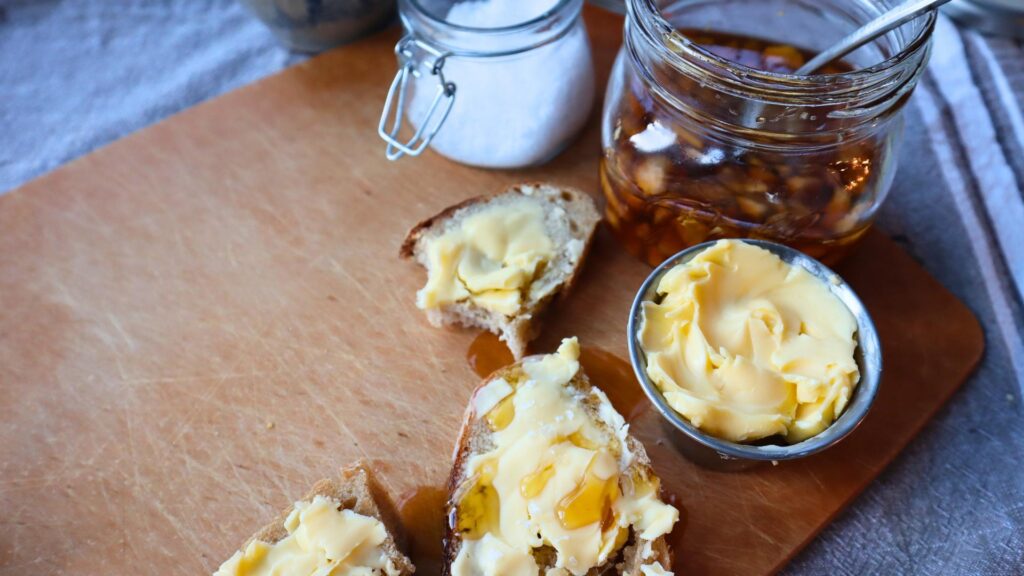Cultured butter is a slightly tangy, probiotic rich version of classic butter. Making cultured butter at home might be easier than you think!

What is cultured butter?
Cultured butter is butter that has been made with cultured cream. Culturing cream means to inoculate regular heavy cream with probiotic cultures and ferment it at room temperature. This cultures the cream which you can then use to make cultured butter.
Is making cultured butter at home hard?
If you’ve made homemade butter in your kitchen then making cultured butter is not hard. It’s the same as making butter with one added step of culturing your cream first.
Ingredients for making cultured butter
- Heavy whipping cream. Pasteurized is okay, but avoid ultrapasteurized.
- Starter culture like living whey, yogurt, kefir, or clabbered milk.
- Salt (optional)
Making cultured butter at home
Making cultured butter at home is the same process at making butter at home plus one extra step, you need to culture the cream first.
After the cream is cultured you use it to make butter just as you would with regular cream.
Butter is made by whipping the cream for long enough that the fat sticks together and separates from the water, known as buttermilk. This is the same process as making whipped cream, but you take it to the next level.

Equipment for making cultured butter at home
You can definitely make butter by hand, but it take some effort. There’s a whole lot of whisking involved. Thankfully, there are many modern tools that can be used to whip up a batch of butter. Pick your preferred tool. The best tool to use is one you already have in your own kitchen.
Butter Churn
It’s this old fashioned gadget that’s made just for churning butter. I have an old butter churn that was my husbands great grandmothers. It’s very special. They still make these today. Not only are they useful for making butter, you can make whipped cream and beat eggs for your omelet until they’re frothy. Check out this classic old fashioned butter churn on Amazon.
Stand Mixer
Stand mixers are a workhorse in a busy scratch made kitchen. They have so many uses from whipping cream, to kneading dough and beating air into butter and sugar for making the perfect cookies. Most modern stand mixers also have optional attachments that can make pasta, grind meat, make sausage and more. We love our Kitchen Aid stand mixer, but it’s getting old! A testament to the brand, this stand mixer has been in my family for over forty years! We’ll soon be purchasing a new stand mixer, and I have my eye on this new commercial grade Kitchen Aid.
Hand Mixer
Making butter can be done using a hand mixer. I have this cheap off brand one and it works great for so many things.
Immersion Blender
People do it, but I never have. If you have a whisk attachment for your immersion blender like with this model, use that.
Food Processor
I have made butter in my food processor many times and it works great. Easy to make an a quick clean up. I have this 14 cup Cuisinart Food Processor and I love it fo so many things.
How to culture cream
- Place heavy whipping cream in a glass jar
- Stir in a couple tablespoon of a starter culture. That could be kefir, kefir whey, or clabbered milk. You can also buy specific mesophilic culture here.
- Leave cream at room temperature to ferment covered with a loose fitting lid for 12-24 hours.
- The cream is done when it’s thickened, but not separated.
- Use cultured cream to make cultured butter or use as you would sour cream.
Making cultured butter
- Add cultured cream to a large bowl or stand mixer.
- Beat until butter forms. It will form whipped cream first, keep going until the fat separates from the buttermilk.
- Remove the butter solids from the buttermilk.
- Rinse with cold water and squeeze out as much buttermilk as possible.
- If using, add salt and knead in, mixing evenly.
- Store in a covered butter dish in the refrigerator until ready to use.
Ways to use cultured butter
Cultured butter can be used for anything that you would normally use butter for. From spreading on toast, to baking with or making flavored compound butters. Use cultured butter in place of butter in a any application or recipe.
I love highlighting this homemade butter when I take the time to make it. I’m more likely to spread it on toast than to use it to fry an egg or bake something. Homemade butter on homemade sourdough with my fermented honey garlic is pretty much as good as it gets.
How is cultured butter different that regular butter?
The only difference is the act of fermenting the cream before making it into butter. This adds healthy probiotic bacteria to the butter, but it also enhances the flavor. Cultured butter is a bit tangy and more exciting than regular butter.
If you’ve never had fresh homemade butter before, you’re in for a treat. It’s excellent and tastes so much more fresh than store bought butters. Take it to the next level by culturing it and you get the freshness along with the slight tanginess that comes with culturing dairy. It’s a win win.
how to preserve cultured butter
By culturing your cream before making this butter you are already adding beneficial bacteria that may help to keep your homemade butter fresh for longer. Salt is also a great preservative and helps keep bad bacteria from multiplying.
The best way to preserve cultured butter at home for long term is to freeze it.
To freeze your cultured butter simple wrap it tight in parchment or plastic wrap and place it in a ziplock bag with the contents and date written on it. Alternatively you could freeze your butter in molds or ice cube trays then pop them out and move them to a plastic bag or Tupperware and keep them in the freezer until you’re ready to use them.

Why make cultured butter?
Culturing butter is just another way to have a little fun in the kitchen bringing life back into your food. If all you can access is conventional butter and pasteurized cream, culturing butter is adding back living probiotic bacteria to your dairy and enhancing its benefits.
On top of that, cultured butter has an excellent flavor and can be used in so many ways.
What type of cream to buy to make cultured butter?
You can use pasteurized heavy cream or heavy whipping cream for this recipe. Thankfully, because raw cream is pretty hard to come by. I buy my raw milk from a local dairy, they do not separate cream. That means we could separate cream from our raw milk to make butter. I chose not to though, because the cream in the milk tastes delicious and is worth more to me than the little amount of butter we would yield from skimming it off.
We have another local dairy that sells their pasteurized heavy whipping cream. It’s affordable and it’s what I prefer to use when making butter, cultured or otherwise. We also use it for making ice cream and whipped cream as well.
By adding the starter culture, you are starting the process of fermenation on the right foot. Adding the beneficial bacteria back into the otherwise ‘dead’ food. Pasteurization has removed those natural bacteria in the milk. Adding them back in is necessary to culture the pasteurized cream.
If you were able to get your hands on real, raw unpasteurized cream consider yourself lucky! You may be able to culture that just by leaving it on the counter at room temperature. To be on the safe side, I still recommend adding that starter culture to make sure the good guys are in favor.
You May also like

Making Cultured Butter at Home
Ingredients
- 1 quart heavy cream raw or pasteurized but not ultra-pasteurized
- 2 tablespoons starter culture see notes
- Salt to taste optional
Instructions
- Place 1 quart heavy cream into a glass mason jar and stir in 2 tablespoons of starter culture (see notes).
- Cover with a loose fitting lid and let ferment at room temperature for 12 to 24 hours.
- The cream is cultured when it is thickened and smells pleasantly sour.
- Pour cream into food processor, blender or stand mixer and blend until the butterfat separates from the buttermilk.
- Strain butter fat out and press it together. Rinse it with cold water and squeeze out as much liquid as possible.
- Knead is salt to taste if using.
- Store in a airtight container in the refrigerator.
pin it for later







Leave a Reply